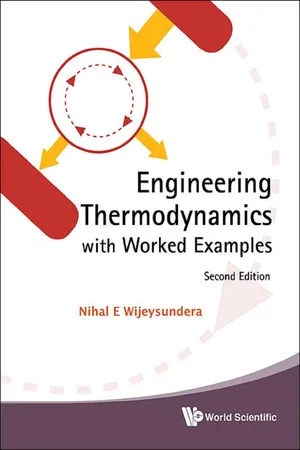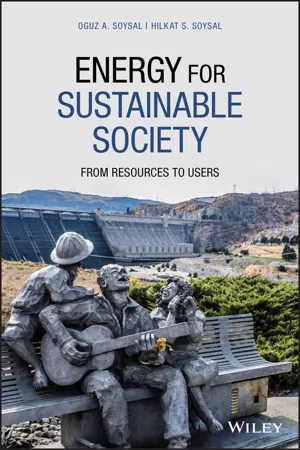Technology & Engineering
Vapor Power System
A vapor power system is a type of energy conversion system that uses a working fluid in the vapor phase to generate power. This typically involves the use of a heat source to produce steam, which is then used to drive a turbine or other power-generating equipment. Vapor power systems are commonly used in power plants and other industrial applications to produce electricity.
Written by Perlego with AI-assistance
Related key terms
4 Key excerpts on "Vapor Power System"
- eBook - ePub
- Nihal E Wijeysundera(Author)
- 2016(Publication Date)
- WSPC(Publisher)
Chapter 9
Vapor Power Cycles
In this chapter we shall consider the analysis of vapor power cycles that convert the stored energy of fuels to mechanical work. The main distinguishing feature of these power cycles is that the working fluid undergoes phase change during the operation of the cycle. Steam power plants, which use water as the working fluid, generate much of the electrical power in the world. Although the design and construction of such power plants involve many engineering considerations, our focus in this chapter will be the thermodynamic aspects that impact on the efficiency of the plant.9.1The Carnot Cycle Using a Vapor
In chapter 6 we discussed the operation of the Carnot heat engine cycle and derived an expression for its efficiency when the working fluid is an ideal gas. The feasibility of operating a Carnot cycle using a vapor is considered in this section. Figure 9.1 shows the T-s diagram of a Carnot cycle in which all processes occur within the liquid-vapor region. The working fluid enters the evaporator at 4 as a saturated liquid where it is heated to a saturated vapor state and exits at 1. The vapor undergoes an isentropic expansion 1-2 to produce a work output. During the condensation process 2-3 the wet vapor rejects heat to a heat sink at constant temperature. Finally, the vapor is compressed from 3 to 4 in an isentropic compression process to complete the cycle.We now apply the SFEE to each of the steady-flow processes of the cycle, neglecting the kinetic and potential energy of the fluid, to obtain the following expressions. Fig. 9.1 Carnot cycle using a vapor For the process 4-1 in the evaporator:where is the steady mass flow rate of the working fluid.For the heat removal process 2-3: Applying the first law to the cycle, the net work output is The efficiency of the cycle 1-2-3-4 is given byManipulating Eqs. (9.1) to (9.4) we haveWe relate the enthalpy changes in Eq. (9.5) - eBook - ePub
Applied Thermodynamics
Availability Method And Energy Conversion
- Kam W. Li(Author)
- 2018(Publication Date)
- CRC Press(Publisher)
CHAPTER EIGHTELECTRIC-POWER GENERATING SYSTEMSThe thermodynamics of electric-power generating systems has long been a classical study area for engineers. The objectives of such study traditionally have been the determination and maximization of the system efficiency. The usual approach is to apply the first law of thermodynamics and to minimize the fuel input for a given electric output. As indicated in the previous chapters, the first law is not sufficient and so the concept of availability must be utilized. In this chapter we apply the availability method to electric-power generating systems. These systems will include steam turbine, gas turbine, and combined-cycle systems. In addition to the calculation of the system second law efficiency, attention will be focused on the availability losses and destruction among the components. We will also identify the component in which the most availability loss and destruction occurs. This critical component should be the key area in any power plant-improvement project.8-1 STEAM TURBINE SYSTEMSThe steam turbine power plant system consists of four major components: boiler, turbine-electric generator, condenser, and pump. As shown in Fig. 8-1 , steam leaves the boiler at high pressure and high temperature and enters the turbine for expansion. In the turbine expansion process, the steam’s thermal energy is converted into first mechanical work and then electrical energy through the electric generator. At the turbine exhaust end, steam is usually at low-pressure and saturated conditions. Then the steam passes through a condenser and exits as a saturated liquid. In the final process, the water is pumped back to the boiler and completes the steam turbine cycle. The steam turbine cycle efficiency is the ratio of the cycle net output to the cycle input. That is,η cy=w st−w pq b(8.1) Figure 8-1 Schematic diagram for a steam turbine system.The cycle net output is the turbine-generator output minus the pump power. The cycle input is simply the thermal energy received by the water and steam. The second law cycle efficiency is defined as the ratio of the cycle availability output to the cycle availability input. In an equation form, it is - eBook - ePub
Energy for Sustainable Society
From Resources to Users
- Oguz A. Soysal, Hilkat S. Soysal(Authors)
- 2020(Publication Date)
- Wiley(Publisher)
Figure 7.11 achieves a higher thermal efficiency by using the exhaust gas from Brayton cycle to heat the working fluid in Rankine cycle. The net efficiency of a combined cycle turbine system is equivalent to a thermodynamic cycle operating between the higher temperature of the Brayton cycle and the lower temperature of the Rankine cycle. Efficiencies around 60% are common for combined cycle turbine systems.7.10.2 Combined Heat and Power (CHP) Systems
In CHP systems, the released heat from the fluid exiting the turbine is used for heating of industrial process, commercial buildings, building complexes, or public services. In a CHP power plant using steam turbines, the condenser operates at a higher temperature than a conventional power plant. CHP systems are common in waste‐to‐energy and geothermal energy systems. Because of the high cost of thermally insulated pipelines and other infrastructure to convey steam to a long distance, such systems are more convenient for industrial process heating and district heating in densely populated areas.7.11 Chapter Review
Thermodynamics is the study of interactions between heat and mechanical work. In the sense of thermodynamics, heat is an energy interaction due to temperature difference. Temperature is the measure of hotness or coldness. When two objects are at the same temperature, they are said to be in thermal equilibrium and no thermodynamic interaction occurs. Celsius and Fahrenheit scales are commonly used to express temperature. Both temperature scales are standardized using the freezing and boiling temperatures of pure water. Absolute temperature scales use a single reference temperature and use the unit Kelvin (K).Internal energy is the total kinetic and potential energy of atomic particles in a substance or object. Thermodynamic processes cause changes of internal energy.The conservation of energy principle is known as the first law of thermodynamics. According to the first law of thermodynamics, the net heat processed in a system is equal to the sum of the internal energy change and mechanical work - eBook - ePub
Sustainable Design Through Process Integration
Fundamentals and Applications to Industrial Pollution Prevention, Resource Conservation, and Profitability Enhancement
- Mahmoud M. El-Halwagi(Author)
- 2011(Publication Date)
- Butterworth-Heinemann(Publisher)
Fig. 8.4 , the power plant includes a boiler that corresponds to the high-temperature heat source where a fuel is burned to transfer heat to water, thereby producing high-pressure steam. The high-pressure steam is directed toward a turbine where the pressure energy of the steam is converted into rotational energy in the form of a shaft work. The shaft work can be converted to electric energy through an electric generator. The steam leaving the turbine is cooled/condensed, and the condensate is fed to a pump that increases the pressure of the condensate and returns the water back to the boiler to be heated, transformed into steam, and the cycle continues. Typically, the generated work from the turbine is significantly higher than the work used in the pump. Therefore, the net effect of the system is that the heat from the boiler is converted into work while the discharged heat (with the steam exiting the turbine) is transferred to the condenser that serves as the low-temperature heat sink.Figure 8-4 A schematic representation of a steam power plant.A useful tool for representing the thermodynamic aspects of the steam power plant is the Mollier diagram (for example, Smith et al., 2005 ). There are several forms of the Mollier diagram. One form is the temperature versus entropy representation. Consider the vapor-liquid portion of the Mollier diagram shown by Fig. 8.5 . The curved line to the left of the critical point is the saturated-liquid line while the curved line to its right is the saturated-vapor line. To the left of the saturated-liquid line lies the subcooled-liquid region and to the right of the saturated-vapor line lies the superheated-vapor region. The area under the curve is the two-phase liquid-vapor region. The dashed path represents heating a liquid from a subcooled state to a superheated state under constant pressure. Under a given pressure, water starts and ends evaporation at the same temperature. Therefore, the two-phase vapor-liquid segment is horizontal.Figure 8-5 The temperature-entropy Mollier diagram.If the steam power plant of Fig. 8.4 is described by a Carnot cycle, then the working fluid (water) undergoes four steps in the following four units (as shown by Fig. 8.6
Index pages curate the most relevant extracts from our library of academic textbooks. They’ve been created using an in-house natural language model (NLM), each adding context and meaning to key research topics.



